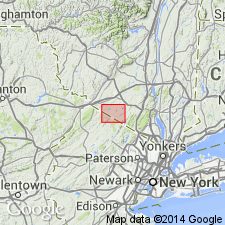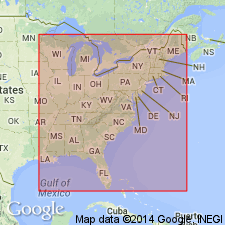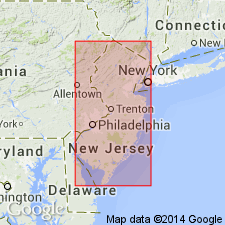
- Usage in publication:
-
- Mount Eve Granite*
- Modifications:
-
- Named
- Dominant lithology:
-
- Granite
- AAPG geologic province:
-
- Appalachian basin
Summary:
The informal Mount Eve granite of Hague, J.M., Baum, J.L., Herrmann, L.A., and Pickering, R.J. (1956, Geology and structure of the Franklin-Sterling area, N.J.: GSA Bull. 67, no. 4, p. 435-474) is here formally named Mount Eve Granite. Consists of coarse- to medium-grained, light-gray rock containing microcline, microperthite, quartz, oligoclase, and biotite, with accessory allanite and magnetite. Granite is undeformed with no evidence of strain or recrystallization, but at many places it has flow foliation and lineation. Cuts across layering, foliation, and folds in the metamorphic rocks of the Pine Island, Unionville, and Hamburg quads, all of which it intrudes, including the Franklin and Wildcat Marbles and the Losee Metamorphic Suite. A granodiorite body in the Newton East quad. that resembles Mount Eve but differs petrographically and chemically intrudes the Byram Metamorphic Suite. Contains abundant inclusions of country rocks.
Source: GNU records (USGS DDS-6; Reston GNULEX).

- Usage in publication:
-
- Mount Eve Granite*
- Modifications:
-
- Geochronologic dating
- AAPG geologic province:
-
- Appalachian basin
Summary:
Mount Eve Granite has U-Pb zircon age of 1020 +/-4 Ma (Drake and others, 1990, Geological Society of America, Abstracts with Programs, v. 22, p. 12).
Source: GNU records (USGS DDS-6; Reston GNULEX).

- Usage in publication:
-
- Mount Eve Granite
- Modifications:
-
- Areal extent
- AAPG geologic province:
-
- Appalachian basin
Summary:
Rocks mapped as Mount Eve Granite occur in the extreme northern Highlands, where they straddle the NJ-NY border. They are confined in NY to the Pine Island, Unionville, Wawayanda, and Hamburg quads. They are massive, moderately to indistinctly foliated granite that is light gray to pinkish-gray and medium- to coarse-grained. Clearly a synorogenic to postorogenic granite. Is discordant to lithologic contacts in adjacent units, contains inclusions of local metasedimentary rock, and has produced contact aureoles in the Franklin Marble.
Source: GNU records (USGS DDS-6; Reston GNULEX).
For more information, please contact Nancy Stamm, Geologic Names Committee Secretary.
Asterisk (*) indicates published by U.S. Geological Survey authors.
"No current usage" (†) implies that a name has been abandoned or has fallen into disuse. Former usage and, if known, replacement name given in parentheses ( ).
Slash (/) indicates name conflicts with nomenclatural guidelines (CSN, 1933; ACSN, 1961, 1970; NACSN, 1983, 2005, 2021). May be explained within brackets ([ ]).

